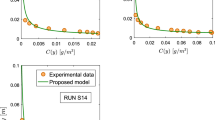Abstract
In a paper published in Environmental Fluid Mechanics, Kundu proposed an interesting study about modeling suspended sediment concentrations profiles in turbulent open-channel flows. The used model is based on fractional advection–diffusion equation and incorporates the effects of non-local transport of particles, stratification, hindered settling velocity and damping of mixing length. Kundu’s model needs vertical profiles for mixing velocity and mixing length. Despite the interest, the study shows a weakness about Kundu’s choice of these two parameters and a related contradiction. Due to this shortcoming, the proposed model of sediment diffusivity is questionable. In this note, the weakness is pointed out. We comment on the choice of Kundu of these two parameters which are in contradiction with the used parabolic neutral eddy viscosity profile. We show that velocity profiles obtained from an eddy viscosity based on Kundu’s parameters are inaccurate. The mixing velocity and the model of sediment diffusivity are corrected and improved eddy viscosity formulations are presented.


Similar content being viewed by others
References
Absi R (2021a) Analytical eddy viscosity model for velocity profiles in the outer part of closed- and open-channel flows. Fluid Dyn 56
Absi R (2021) Reinvestigating the parabolic-shaped eddy viscosity profile for free surface flows. Hydrology. https://doi.org/10.3390/hydrology8030126
Nezu I, Rodi W (1986) Open channel measurements with a laser Doppler anemometer. J Hydraul Eng ASCE 112(5):335–355
Coles DE (1956) The law of the wake in the turbulent boundary layer. J Fluid Mech 1:191–226
Nezu I, Nakagawa H (1993) Turbulence in open channel flows, A.A. Balkema, Ed. Rotterdam, The Netherlands
Absi R (2006) A roughness and time dependent mixing length equation. Jpn Soc Civ Eng Doboku Gakkai Ronbunshuu B 62:437–446
Langhi M, Hosoda T, Dey S (2018) Analytical solution of k-ϵ model for nonuniform flows. J Hydraul Eng ASCE 144(7):04018033
Nakagawa H, Nezu I, Ueda H (1975) Turbulence of open channel flow over smooth and rough beds. Jpn Soc Civ Eng 241:155–168
Welderufael M, Absi R, Mélinge Y (2021) Assessment of velocity profile models for turbulent smooth wall open channel flows. ISH J Hydraul Eng. https://doi.org/10.1080/09715010.2019.1677180
Hosoda T (1990) Turbulent diffusion mechanism in open channel flows. PhD thesis. Koyoto University
Nielsen P, Teakle IAL (2004) Turbulent diffusion of momentum and suspended particles: a finite-mixinglength theory. Phys Fluids 16:2342–2348
Absi R (2005) Comment on “Turbulent diffusion of momentum and suspended particles: a finite-mixing-length theory.” Phys Fluids 17(7):079101
Absi R (2008) Analytical solutions for the modeled k-equation. ASME J Appl Mech 75:044501
Absi R (2010) Concentration profiles for fine and coarse sediments suspended by waves over ripples: an analytical study with the 1-DV gradient diffusion model. Adv Water Res 33(4):411–418
Absi R (2019) Eddy viscosity and velocity profiles in fully-developed turbulent channel flows. Fluid Dyn 54(1):137–147
Absi R (2003) Wave boundary layer instability near flow reversal, In: Coastal Engineering 2002, Proc 28th Inter Conf Coast Eng, ASCE, Jane McKee Smith (Ed.), World Scientific Publishing, vol. 1, pp. 532–544.
Absi R (2011) An ordinary differential equation for velocity distribution and dip-phenomenon in open channel flows. J Hydraulic Res 49(1):82–89
Author information
Authors and Affiliations
Corresponding author
Additional information
Publisher's Note
Springer Nature remains neutral with regard to jurisdictional claims in published maps and institutional affiliations.
Rights and permissions
About this article
Cite this article
Absi, R. Comments on «Modeling stratified suspension concentration distribution in turbulent flow using fractional advection–diffusion equation» by Snehasis Kundu, environmental fluid mechanics, https://doi.org/10.1007/s10652-019–09,679-9. Environ Fluid Mech 21, 1189–1196 (2021). https://doi.org/10.1007/s10652-021-09821-6
Received:
Accepted:
Published:
Issue Date:
DOI: https://doi.org/10.1007/s10652-021-09821-6




